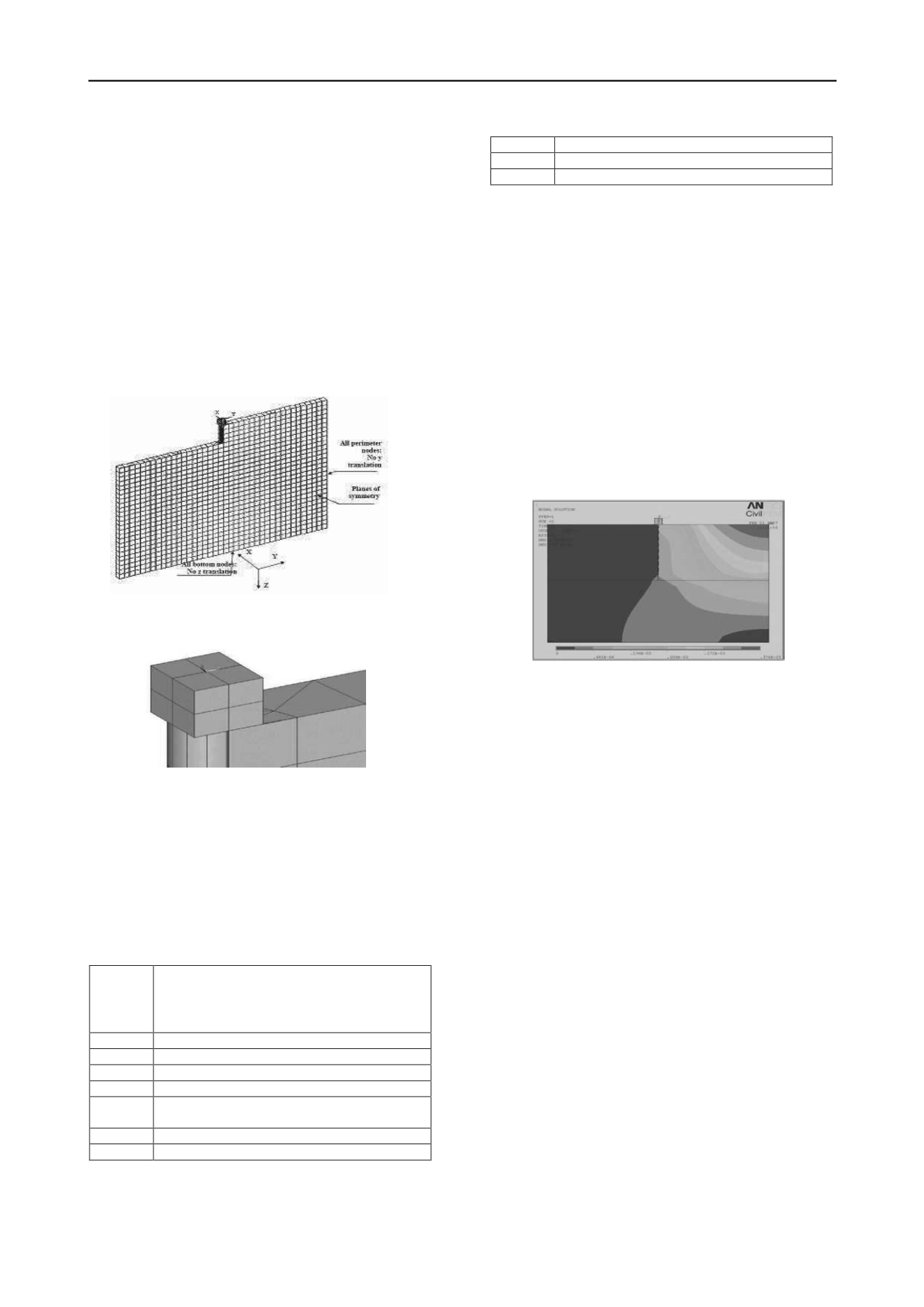
1936
Proceedings of the 18
th
International Conference on Soil Mechanics and Geotechnical Engineering, Paris 2013
of the symmetry plane have been constrained in direction
perpendicular to the plane of symmetry.
The interface between the pile and soil have been represented by
a couple of 8 node contact element named CONTACT 170 and
8 node target elements named TARGET 174, that was described
in the chapter 3. The purpose of this couple is to mimic the
installation effects on piles (drilled or driven). It also serves a
purpose of a simplified interface which allows for tension cut-
off (gaping) and controlled, coupled horizontal and vertical
stiffness. The contact between pile and soil was supposed to be
rough and were simulated by Drucker
–
Prager model with a
friction angle of value corresponding to each layer.
Figure (1-a): 3D Finite Element Model for Contiguous Piles Wall.
Figure (1-b): Pile Cap Mesh.
3.
2B
LOADING CONDITIONS
Loading for this case is presented in Table (1). The pile cap has
been proposed to laterally load P at the pile head in the negative
direction of y axis, in addition to surcharge load, with
excavation at various stages. Ten load cases were performed to
simulate the lateral load test loads and study the pile behaviour
under different load cases and compare with measured results
Table (1) Applied Load in Each loading Case for Contiguous Piles Wall.
Load
case
No.
Applied load (P)
(kN)
1
Before Applying surcharge load of 20 kN/m
2
Applying surcharge load of 20 kN/m
3
After excavation to -2.5 m from ground level
4
After excavation to -5 m from ground level
5
24 hrs after excavation to -5 m from ground
level
6
Applying 21 ton horizontal load
7
After releasing 21 ton horizontal load
8
Just after Applying 300 kN horizontal load
9
24 hrs after Applying 300 kN horizontal load
10
After releasing 300 kN horizontal load
4.
3B
RESULTS AND DISCUSSION
4.1
4B
Pile-Soil Deformation
Figures (2-a, b, c, d, and e) show the contour of pile and soil
movement in direction Y axis, the deflection along the pile for
the load cases no 2, 3, 4, 6, and 8.
In figure (2-a), after applying a vertical surcharge It is
interesting to note that the plastic zone propagates deeply with a
high densification in top layers till reaches the minimum values
at the end of the model and extended below, this means that the
settlement under the surcharge induced a lateral movement to
the pile towards the settled side (right side), but the pile was
rigid enough to retain the other side without movement
especially the movements was very low so it does not extend far
from the pile. Moreover, the instrumented side (right side)
features much larger plastic zone while the plastic zone for the
extension side (left side) is confined to the interface layer.
Figure (2-a) Contour of Deflections along the Pile under Surcharge
Load .
In figure (2-b), after excavation to -2.5 m from ground level, It
is noted that the excavation process resulted in a lateral
movement of pile towards the excavation, and a small wedge of
soil in front of the pile (left side) exhibits a small movement
mobilizing a passive resistance in the front of the pile, but the
right side is still affected by the surcharge load settlement which
moves the soil very slightly in opposite direction
In figure (2-c), after excavation to -5.0 m from ground level, It is
noted that the increase of excavation process resulted in
increasing the lateral movement of pile towards the excavation,
increasing the wedge of soil in front of the pile (left side)
exhibits a bigger movement mobilizing a passive resistance in
the front of the pile than the previous case, but the right side is
still affected by the surcharge load settlement which moves the
soil very slightly in opposite direction but less than the previous
case.
In figure (2-d), Applying 21 ton horizontal load, It is noted that
applying lateral load in increasing the lateral movement of pile
towards the excavation, resulted increasing the wedge of soil in
front of the pile (left side) exhibits a bigger movement
mobilizing a passive resistance in the front of the pile the
movement propagates deeper than the previous case and, but the
right side is still affected by the surcharge load settlement which
moves the soil very slightly in opposite direction but less than
the previous case .


